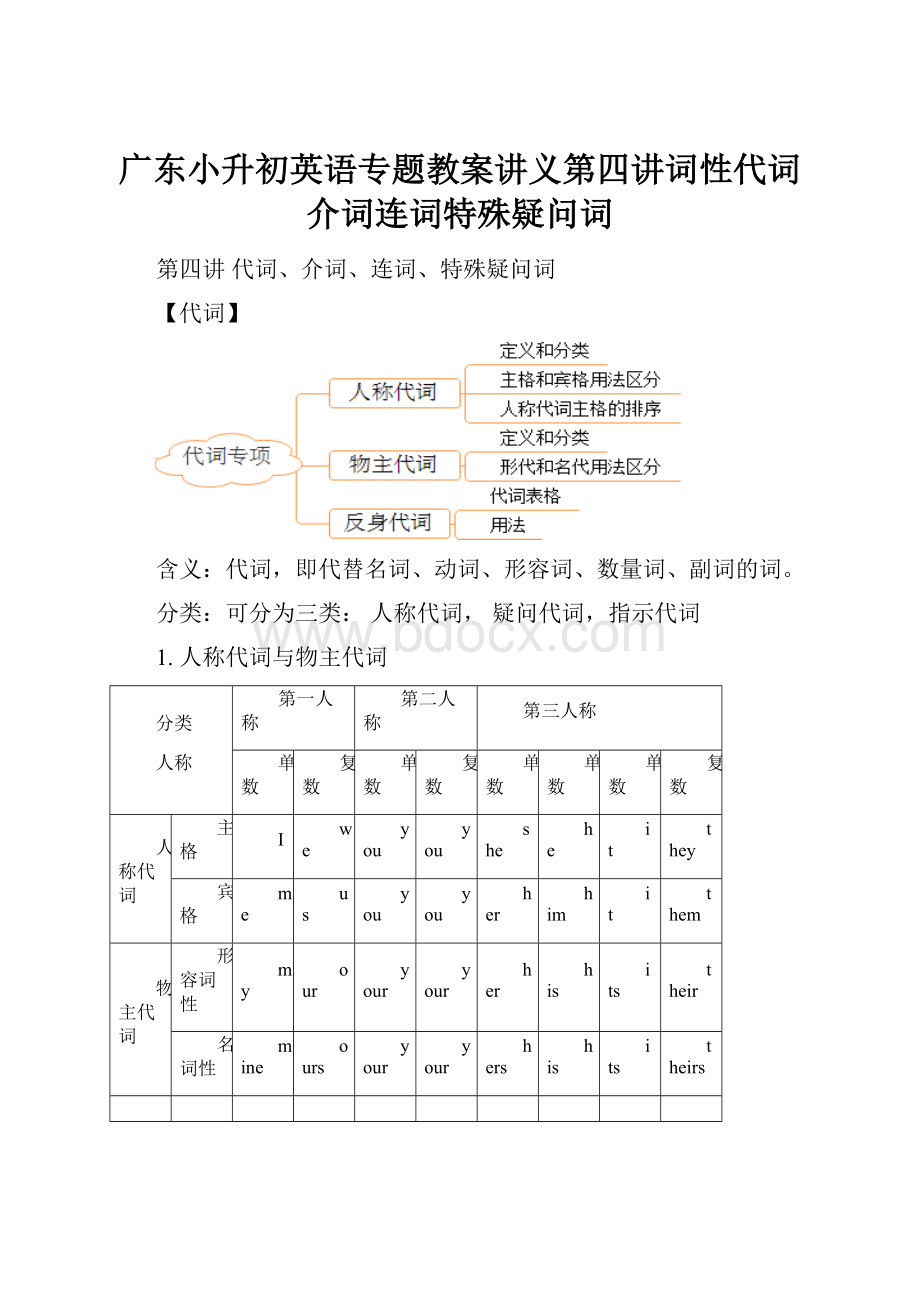广东小升初英语专题教案讲义第四讲词性代词介词连词特殊疑问词.docx
《广东小升初英语专题教案讲义第四讲词性代词介词连词特殊疑问词.docx》由会员分享,可在线阅读,更多相关《广东小升初英语专题教案讲义第四讲词性代词介词连词特殊疑问词.docx(17页珍藏版)》请在冰豆网上搜索。

广东小升初英语专题教案讲义第四讲词性代词介词连词特殊疑问词
第四讲代词、介词、连词、特殊疑问词
【代词】
含义:
代词,即代替名词、动词、形容词、数量词、副词的词。
分类:
可分为三类:
人称代词,疑问代词,指示代词
1.人称代词与物主代词
分类
人称
第一人称
第二人称
第三人称
单数
复数
单数
复数
单数
单数
单数
复数
人称代词
主格
I
we
you
you
she
he
it
they
宾格
me
us
you
you
her
him
it
them
物主代词
形容词性
my
our
your
your
her
his
its
their
名词性
mine
ours
your
your
hers
his
its
theirs
2.反身代词
数
人称
单数形式
复数形式
第一人称
myself
ourselves
第二人称
yourself
yourselves
第三人称
himself/herself/itself
themselves
不定人称
oneself
常考搭配:
byoneself靠某人自己teachoneself=learnbyoneself自学
helponeselfto随便吃点enjoyoneself玩得开心
反身代词的构成规律记忆口诀
反身代词有规律,第三人称宾格加,其余开头用物主,复数ves替f
3.指示代词:
this,these,that,those
指示代词用法口诀:
介绍人物用指代,thisthese距我近,
thatthose离我远,thisthat指单数。
thesethose表复数,单复加be不相同,
thisthat跟is,回答事物it代。
thesethose必加are,回答人/物they来替,
若是what提问物,回答要用it/they。
若是用who提问人,人称代词来应答,
无论单数与复数,其后都可加名词。
情景若是打电话,I’m和You’re可不行,
Thisis指我是,Thatis说对方。
that/those置than后,代替前面同类物。
指示代词:
指示代词
用法
单数
复数
离谈话对方_____________的人或物
离谈话对方_____________的人或物
4.疑问代词
疑问代词在句中起名词词组的作用,用来构成疑问句。
疑问代词有:
what,who,whose,whom,which,whatever,whichever,whoever,whomever
5.不定代词
由some,every,no,any分别与one,thing和body组合即可得到以下复合不定代词:
-some
-any
-no
-every
-body
-one
-thing
复合不定代词用法:
复合不定代词作主语时,谓语动词用_______________形式。
修饰形容词时,放在______________________________________________。
后面可以跟________________(todo/doing)。
some与any的用法:
一些
some
用于 ___________________________________________
any
用于 ___________________________________________
each和every的用法:
每一
each
强调 __________ (整体/个体);作主语时,谓语动词用 __________(单数/复数)形式;指两个或两个以上中的每一个。
every
强调 __________ (整体/个体);作主语时,谓语动词用 __________(单数/复数)形式;指三个或三个以上中的每一个。
【介词】
1:
介词的定义和分类
1)介词(preposition简写__________.)又称作__________(前置/后置)词,表示名词、代词等与句中其他词的关系,在句中__________(能/不能)单独作
。
2)介词可以分为__________介词,如:
inthemorning;__________介词,如:
athome;__________介词,如:
bycar;__________介词,如:
intheeast以及原因介词、数量介词和其他介词。
本讲主要学习时间介词、地点介词,方位介词和方式介词的用法。
2:
时间介词in/on/at的用法
介词in/on/at用法:
1)__________后接:
年份、季节、月份或一段时间,如:
inthemorning/afternoon/evening; inautumn;inFebruary;in2016;inaweek(in+一段时间,表将来)
2)__________后接:
星期、具体日期、特定的日子和节日,如:
onMonday/onMondayafternoon; onweekdays;onChildren’sDay; onMarch8th; onasummerevening; ontheeveningofMay1st,2012
3)__________后接时间点和具体时刻。
atseveno’clock; atnoon/night/midnight; attheweekend
3:
地点介词in/on/at的用法
根据图片信息和首字母提示,填入适当的单词,完成句子
(1)
(2)
(3)
(1)Iwasborni__________G__________.
(2)Therearemanyb__________o__________thedesk.
(3)Aliiss__________a__________home.
地点介词in/on/at用法:
1)__________表示地点时,指比较__________(大/小)的场所。
如:
attheschoolgate; athome
attheparty; attheBeijingrailwaystation; atNo.2BakerStreet; atthebusstation。
2)__________表示地点时,指比较__________(大/小)的场所。
如:
inBeijing; inthesouthofAmerica
3)__________表示地点时,中文意思是“__________”,强调与表面接触。
如:
onthemap;onthewall;ontheroad
4:
方位介词in/on/to的用法
看图,用in/on/to填空
(1)Guangdongis__________theeast(东方)ofChina.
(2)Guangdongis__________theeastofGuangxi.
(3)Guangdongis__________thenorth(北方)ofHainanIsland.
介词in/on/to在表示方位时的用法:
1)__________表示在内部,如:
GuangzhouisinthesouthofChina.
2)__________表示毗邻、接壤,如:
CanadaliesonthenorthofAmerica.
3)__________表示“在……范围外”,强调不接壤、不相邻,不包含。
如:
JapanliestotheeastofChina.
5:
方式介词by/with/in/on/的用法
你会搭车吗?
看图,根据首字母提示,填入适当的单词,完成句子。
(1)
(2)
(3)
(4)
(1)Sallyusuallygoestos__________b__________bike.
(2)TheChenfamilywillgototheb__________i__________acar.
(3)InGuangzhou,manyyoungpeoplegotow__________o__________abus.
(4)Westernpeoplehavetheirmealsonaplatew__________ak__________andfork.
介词by/in/on/with在表示方式、手段或工具时的用法:
1)__________:
凭借工具或手段,名词前不用冠词,若后接动词,则用动名词形式。
还可接交通工具的单数名词,且名词前不加修饰词。
如:
bybus,byjoiningtheEnglishclub,byhand
2)__________:
指具体的工具或手段、方法。
如:
withapen.
3)__________:
用于封闭型的交通工具前,且该名词前有限定词。
如:
inacar也可以表示用某种材料以及语言、声音等,名词前不加冠词,如:
inEnglish。
4)__________:
用于开放型或半开放型的交通工具前,且该名词前有限定词。
有时用于固定词组。
如:
onabike;onfoot还可以表示“以…方式”,用于手段、通讯方式等,如:
onthephone
6:
其他介词用法
划出下列句子中的介词写在括号内,并在横线上写出其中文含义
1)Shehasbreakfastbefore7o’clock.
2)I’dliketohavearestafterlunch.
3)Myfatherusuallytakesphotosduringhisholiday.
4)Mr.WhiteisfromAmerica.HegoestoworkfromMondaytoFriday.
5)Thepresentisforhim.Hewaiteditforamonth.
6)Sixisthenumberbetweenfiveandseven.
7)TherearesomeAmericansamongus.
8)Theyaregoingtotakeawalkaroundthelake.
9)Dogoacrossthestreetatthetrafficlights.
10)GoalongZhongshanRoad.
11)Ittakesthemabouttenminutestowalkthroughthepark.
12)TheyaretalkingaboutMoyan.
13)Thelegsofthedeskarered.
14)Mywesternfriendsenjoyfoodlikehamburgers,sandwichesandsalad.
15) AtChristmas,myfatherlikesdressingupastheFatherChristmas.
16) Dr.SunYasentwasagainsttheemperor.
( )_______________
( )_______________
( )_______________
( )_______________
( )_______________
( )_______________
( )_______________
( )_______________
( )_______________
( )_______________
( )_______________
( )_______________
( )_______________
( )_______________
( )_______________
( )_______________( )_______________( )_______________( )_______________
我是小小总结家:
大多数介词都有自己本身的含义,因此句意理解很重要,选用哪个介词很多时候就是通过语境去判断的。
7:
介词短语大集结
试试找出划线部分短语的正确含义:
1)Heis lookingfor hisbike.
A.照顾 B.查阅 C.寻找 D.看着
2)Peter heardfrom hismotheryesterday.
A.听到 B.收到……来信 C.看望 D.接待
3)Theboy is afraid of snakes.(选出划线短语的中文含义)
A.喜欢 B.害怕 C.讨厌 D.捉
4)Moyan isfamousas awriterandhe isfamousfor itsnovels(小说).
A.因……而著名;作为……而著名 B.作为……而著名;因……而著名
C.因……而著名;因……而著名 D.作为……而著名;作为……而著名
5)Itisimpoliteto laughat thedisabledpeople.
A.嘲笑 B.跟踪 C.盯着看 D.开玩笑
常考短语归纳:
看谁知道得多,写出下列短语的含义
1) 介词+名词
onholiday
onfoot
ontheway
ontheleft/right
onTV
onduty
ontime
onsale
inEnglish
inbed
inthebed
infrontof
indanger
introuble
intime
intheend
atthetopof
atwork
athome
onbusiness
forexample
2) 动词+介词
arrivein/at
talkabout
talkwith
waitfor
geton
getoff
lookfor
lookafter
turnon
turnoff
turndown
turnup
puton
takeoff
getup
getto
lookat
listento
worryabout
help…with
dowellin
thinkof
laughat
leavefor
hearfrom
3) 形容词+介词
bedifferentto
begoodat
beinterestedin
belatefor
beworriedabout
begoodfor
becarefulwith
beafraidof
befamousfor
befamousas
morethan
beangrywith
befullof
befilledwith
beproudof
4) 其他
by+ 交通工具
lotsof/alotof
plentyof
atleast
重点比较:
英语中有些词组有没有定冠词the,意思区别很大,此类词组有:
attable
在进餐
atthetable
在桌旁
inhospital
在医院(住院)
inthehospital
在医院(工作或探望……)
inbed
卧病在床
inthebed
躺在床上
in/atchurch
在做礼拜
in/atthechurch
在教堂里
【连词】
1:
连词的定义和分类
1)定义:
连词是用来__________词与词、词组与词组或句子与
、表示某种逻辑关系的虚词。
2)分类:
连词可以表__________(如:
and)、转折__________(如:
but)、__________(如:
because、so)、__________(如:
or)、__________(如:
if)、__________(如:
than)、__________(如:
though)等关系。
连词从结构上还可以分为两大类:
__________连词(如:
and,or,so)和__________连词(如:
when)。
2:
并列连词:
and,or,but
(1)Yaomingistall__________Mr.Panisshort.
(2)Whichcolourisbetter,white,brown,__________purple?
(3)Theyaresinging__________dancing.
并列连词:
and,or,but的用法总结
连词
用法
例句
and
意为“__________、__________”,表__________(并列/转折)。
连接谓语时,两个动词形式要__________。
MaryandTomarebothfromEngland.
Tomlikessinginganddancing.
or
意为“__________、__________”,表示“和”时,用于__________(肯定/否定)句。
Itisn’taballorapet.
Hurryup,oryouwillbelate.
but
意为“__________、__________“,表__________(并列/转折)
Ilikethedress,butitisabittooexpensive.
3:
从属连词:
because,if,when,before,after,until,so,though
连词
用法
例句
because
意为“__________”,表__________(原因/结果),__________(不能/能)与so连用。
TomlikesEnglishbecauseit’sinteresting.
if
意为“__________”,表示假设或条件
Ifitrains,Iwillstayathome.
when
意为“__________”,表示时间
HewaswatchingTVwhenIgothome.
before
意为“__________”,表示两个动作发生的前后关系。
Washyourhandsbeforeyoueat.
after
意为“__________”,表示两个动作发生的前后关系。
Hedoessomeexerciseafterlunch.
until
意为“__________”,表示“直到某个动作发生,另一个动作才发生”。
常用于not…until句型,意为“__________”。
Ididn’tgotobeduntilhecamehome.
so
意为“__________”,表__________(原因/结果),__________(不能/能)与because连用。
Iwashungry,soIatethreehamburgers.
though
意为“__________”,表__________(条件/让步),不能与but连用。
Thoughyouaresick,youmustaskforaleave.
4:
连词词组
1)both...and...意为“......和......都”、“不但......而且......”、“既......又......”,表示并列(两者都)。
She__________speaksand__________Japanese.(她不但会说日语而且还会写。
)
Both__________and____________________students.(他和我都是学生。
)
2)notonly…butalso...表示“不但…...而且…...”,“不仅……而且...”,“既……又...”,表示并列(但是强调后者)。
Wewerenotonly__________,butalso__________.(我们又饿又累。
)
Shelikesnotonly__________butalso__________.(她不仅喜欢游泳而且喜欢跑步。
)
3)aswellas意为“还有......、不但......而且......”,表示并列,但是强调前者。
如:
试试口头翻译例句、注意谓语动词的形式
Heaswellashisfriends likes traveling.
Shecanswimaswellasdance.
4)either…or意为““要么……要么……”,“不是…就是…”,“或者……或者……”,表示选择(二选一)。
__________comeinor__________out.(要么进来,要么出去。
)
Iwanttovisiteither____________________London.(我想参观巴黎或者伦敦。
)
5)neither…nor意为“既不…也不…”、“…和…都不”,表示选择(两个都不选)
Ihave__________time__________money.(我既没时间又没钱。
)
Shelikesneither__________nor__________.(她既不喜唱歌也不喜欢跳舞。
)
6)sothat 意为“以便、为了”,表示“目的”。
Iget